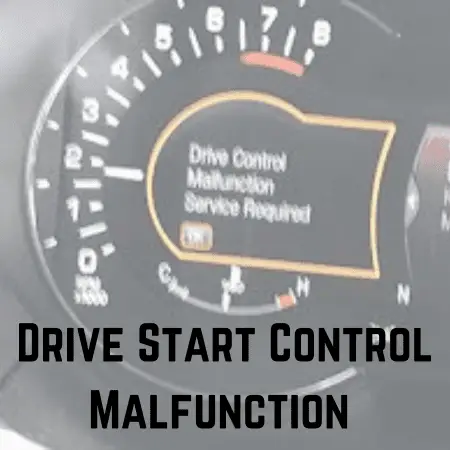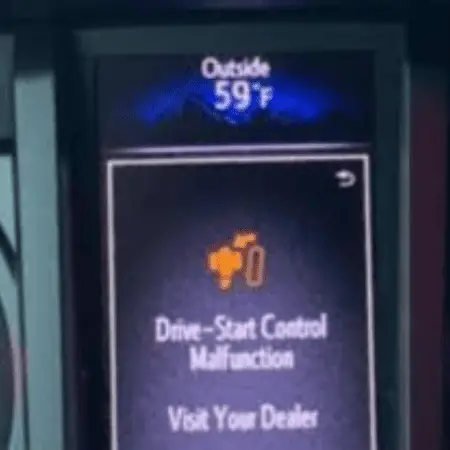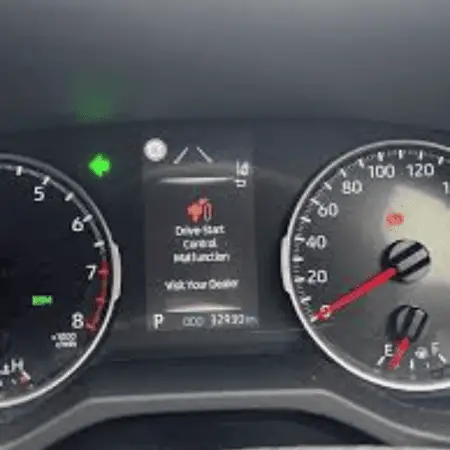A drive start control malfunction happens when there’s a problem with the car system that helps it start moving smoothly. It’s like when you try to start riding your bike, but something isn’t working right with the gears, so it feels jerky or doesn’t move as it should. This can make it tricky to get going from a stop, causing the car to hesitate or jerk when you press the gas pedal. In this article, I will explain the signs and causes of drive start control malfunction. So keep on reading…

What is Drive Start Control?
Drive start control is a system that helps manage how smoothly a vehicle starts moving, especially in situations like driving up a steep hill or on slippery roads. Here’s how it works:
When you start pressing the accelerator pedal in your car, the engine revs up and sends power to the wheels. Normally, this can cause the wheels to spin too fast, which might make it difficult to control the car, especially if the road is slippery or if you’re on a steep slope. Drive start control steps in to prevent this from happening. It regulates the power going to the wheels, making sure they start moving gradually and smoothly. This helps you maintain better control of the car, especially in tricky driving conditions.

Signs of Drive Start Control Malfunction
1- Jerky or Hesitant Acceleration: When you try to move your car forward from a stop, you might feel it jerking or hesitating instead of moving smoothly. It’s like your car is struggling to get going, even though you’re pressing the gas pedal.
2- Delayed Response: You might notice a delay between pressing the accelerator pedal and the car actually starting to move. It’s like there’s a pause or hesitation before the car responds to your input, making it feel sluggish.
3- Unusual Sounds: You may hear strange noises coming from the engine or transmission when you’re trying to accelerate. These could include grinding, whining, or clunking sounds, indicating that something isn’t working right within the drive start control system.
4- Dashboard Warning Lights: Your car’s dashboard might light up with warning symbols, such as the check engine light or a transmission warning light. These lights are like your car’s way of telling you that something is wrong and needs attention.
5- Erratic Behavior: The car might behave unpredictably, such as suddenly surging forward or losing power unexpectedly. This can make driving feel unstable and unsafe, as you’re not sure how the car will respond to your inputs.
6- Difficulty on Inclines: You might find it especially challenging to start moving on uphill slopes, even with normal driving conditions. It’s like your car struggles more than usual to gain traction and move forward smoothly.
You May Find Helpful
- How To Manually Engage AC Compressor Clutch – Step By Step Guide
- How To Turn Off Master Warning Light?
- Does Coolant Affect AC In Cars? Explained
- Are Ventilated Seats Worth It? Pros & Cons Of Ventilated Seats

Common Causes of Drive Start Control Malfunction
1- Sensor Issues:
In the drive start control system, sensors play a crucial role in gathering information about the car’s surroundings and conditions. For instance, sensors monitor wheel speed, traction conditions, and sometimes even vehicle inclination.
If any of these sensors malfunction or provide incorrect data, it can confuse the system. For example, if a wheel speed sensor fails to accurately detect how fast the wheels are turning, the drive start control system may receive incorrect information, leading to improper adjustment of power delivery to the wheels. This can result in jerky or unpredictable movements when starting the vehicle.
2- Electrical Faults:
The drive start control system relies heavily on electrical components to function properly. These components include electronic control units (ECUs), wiring harnesses, solenoids, and actuators.
Any issues with these electrical parts, such as short circuits, corrosion, or faulty connections, can disrupt the flow of information and signals within the system. For instance, if there’s a break in the wiring harness that connects the sensor to the ECU, the system may not receive the necessary data, causing it to malfunction.
Similarly, if the ECU itself experiences a malfunction due to electrical issues, it may fail to interpret sensor data correctly, leading to erratic behavior in the drive start control system.
3- Mechanical Problems:
Mechanical components such as the transmission and clutch play a vital role in the operation of the drive start control system. The transmission is responsible for transferring power from the engine to the wheels, while the clutch helps regulate this power flow.
Over time, these mechanical parts can undergo wear and tear due to usage, leading to issues such as slipping, sticking, or rough engagement. For example, if the clutch is worn out, it may not fully disengage when the driver releases the pedal, causing the vehicle to struggle to move smoothly from a standstill.
Similarly, problems with the transmission, such as gear slippage or improper shifting, can affect the performance of the drive start control system by disrupting the flow of power to the wheels.
4- Software Glitches:
The drive start control system relies on software algorithms to interpret data from various sensors and make real-time adjustments to engine power and transmission settings. However, like any software-driven system, it is susceptible to bugs, errors, and glitches.
These software issues can arise due to coding mistakes, compatibility issues, or even software updates gone wrong. For example, a software bug might cause the drive start control system to misinterpret sensor data, resulting in incorrect adjustments to engine output or transmission gear selection. This could lead to hesitation, jerking, or other irregularities in vehicle movement when starting from a stop.
5- Environmental Factor:
Extreme weather conditions, such as very cold temperatures or heavy rain, can affect the performance of the drive start control system.
Must Read
- Symptoms Of A Bad Clock Spring & How To Fix It
- Is It Safe To Drive With ABS Light On? ( Detailed Answer )
- Car Door Lock Not Working With Key – What To Do
- Can You Drive Without a Muffler? Pros & Cons Of Removing Mufflers
Conclusion
Drive start control malfunction can significantly impact a vehicle’s reliability and performance. By understanding the causes, symptoms, and diagnostic procedures associated with this issue, vehicle owners can take proactive measures to address and prevent drive start control problems, ensuring smooth engine startup and optimal driving experience.
